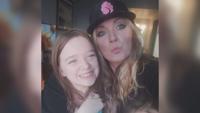
‘Breaking the Silence’: Talking about the impacts of suicide and mental health awareness | News
SPRINGFIELD, Ore. — A grieving mother is sharing her story about the suicide of her young daughter, hoping to raise awareness about mental health, and reduce the stigma that comes with suicide.
“My daughter [Kaleigha], she just turned 13,” Jaimie Brewer said. “She was just a very, very sweet little girl. And I’m not just saying that because she was my daughter. She’s very, very sweet. She thought about everybody. She put herself last.”
Brewer is a Springfield mom, who just experienced an unthinkable tragedy.
“She was battling a little bit of depression and some anxiety issues. And on June 24th, she took her own life,” she said. “And I walked in and found her.”

It’s something we talk about all the time; the statistics, the number of people- the number of children- who take their own lives.
988: National Suicide Prevention Hotline
“Every morning you wake up and think about how you can’t wake her up and say good morning. You can never see her again. And you always feel like, like I still go to say something about her, or to talk to her almost. And she’s not there,” Brewer said.
According to the latest data from the U.S. Centers for Disease Control (CDC), in 2021, more than 48,000 people killed themselves. That number jumped by 2.6% last year, when nearly 50,000 people took their own lives.
Here in Oregon, a report released by Lane County Public Health, dubbed ‘Suicide in Lane County’, tells us the numbers in our state are astronomical.

According to that report, Oregon’s suicide rate has been consistently higher than the national average for more than 30 years. It also said between 2000 and 2020, 1,458 people died by suicide in Lane County alone.
Dan Isaacson is a local advocate for mental health awareness in Lane County. He said in 2023 alone, eight children have died by suicide.
“We rank last in mental health care funding around the country, we’re first in addiction,” Isaacson said. “I think oftentimes, we’re at odds because we’re living in conflict with our values. But that’s changing. I mean, we go through our lives thinking this is just normal but it’s not.”
This summer, Governor Tina Kotek and the Oregon Legislature signed six bills to address what some call ‘the behavioral health crisis in Oregon’.
These bills will send funding to various areas; for example, $7.7 million going to child and adult suicide prevention, $4.9 million to community mental health programs for jail diversion services, and much more.
“It’s a drop of the bucket, and it took 40 years to get to this point. It’s not going to be a one legislative session to get out of it,” Isaacson said. “It’s going to require a consistent change in the way we think about the problem, rather than just throwing money at it.”
Isaacson and others said talking about it in our own homes, with our friends and family, will help destigmatize suicide.

Todd Noble is the Public and Mental Health Director in Linn County.
He said one of the main things his team keeps in mind when talking about mental health issues is open-mindedness.
“We don’t want it to be uncomfortable, we want it to be an open discussion, and breaking down stigma,” Noble said.
They do that by keeping a therapist in all of their schools. Noble said that way, you don’t disrupt a child’s day, and it can be much easier to open up about their struggles. And it doesn’t stop at the schools; Linn County Mental Health officials also go to any area to simply talk about suicide prevention and mental health help.

“That’s part of prevention, is not only providing the service, but also breaking down those stigmas and realizing it is not a weakness, we’re all human, and to be human means you’re going to have struggles at times, and mental health is very important,” Noble said.
In Eugene, the Eugene School District 4J has a program called ‘Care Solace’. It’s a mediation tool between a patient and a mental health provider.


In Benton County, there’s a strong connection between mental health and law enforcement.
The ‘Crisis, Outreach, Response and Engagement’ team, or CORE, is a relationship between the Benton County Health Department and Corvallis Police. It was created after a 58% increase in calls to police related to mental health services between 2018 and 2021.
“That’s something that we take very seriously, and we make sure our officers are well-trained to respond appropriately to that. Crisis response and deescalation are interwoven into all the training that we give our officers, regardless of topic,” Captain Joel Goodwin said. “Mental health is not something that can be fixed in a 10 or 15 minute window of time, it’s sometimes a lifetime of issues… so from our standpoint, it’s really mostly about how we can connect them with the best resources and get them on path towards a better mental health situation.”
Goodwin said anytime police get a call about someone in crisis, someone from Benton County Mental Health comes along. That’s where people like Eric Bowling come in; he’s the Benton County Program Manager for all things crisis.
“If we were on-site, we’d send one to two people,” he said. “One qualified mental health professional or licensed practitioner do the safety and risk assessment, because our same bar is that of the police departments and sheriff’s department, law enforcement in general — the imminent risk and danger to us to actually take any action. And then we also have the second person who can follow up the next day or the day after and get them connected to services long term.”
According the that report from the CDC, people between the ages of 25 and 65 and older, are at higher risk for suicide.
David Geels is the Behavioral Health Director in Coos County. He said at one point, seven or eight elderly people died by suicide in the county, all around the same time.
He said he and his colleagues tried looking into what may have caused so many people to take their own lives.
“Most of these individuals didn’t reach out for help, there were no indicators they were at risk, most of them had seen their primary care provider within the last month or two, none of them had any significant health concerns either. And so, it was really hard to understand how we would be able to intervene,” Geels said. “You know, a lot of people who are at risk for suicide, they can be very quiet about it, and if there’s not a lot of social people around them who might not notice or engage, it might go unnoticed.”
As we know, it can difficult to talk about what’s going on in our lives; we often don’t want to bother those around us.
But one local man is hoping to change that.

Frank King is an advocate in Lane County. He also is a comedian. The topic of his stand-up routines might be a surprise.
“I am the mental health comedian, which seems like an odd juxtaposition,” King said. “People ask, ‘Wait a minute, a comedian talking about depression and thoughts of suicide? Advocating?”. Well, it runs in my family, it’s called ‘generational depression and suicide.’ my grandmother and my great aunt; I came close enough in 2010. I can tell you what the barrel of my gun tastes like.”

It’s an unconventional way to talk about suicide, to say the least. King uses humor, or in his words funny personal anecdotes to destigmatize mental health issues.
“Helps the difficult topic get digested. Puts people at ease, because it is a taboo subject, even though one person dies by suicide every nine minutes in the U.S., hardly anybody talks about it unless you bring it up. What I discovered was when I brought it up, everybody has got a story,” he said.
Even with people in our communities like King, who are working as hard as they can to make sure everyone feels seen and heard, suicide rates — in Oregon especially — are still high.
Although, according to some data, there was a decrease in suicide rates during the COVID-19 pandemic.
“During COVID we had a consistent talk about mental health, which was great. And there were a lot of bad things that came out of COVID. But one of the gleaming spots that we saw was a reduction in suicide, which we weren’t expecting,” Isaacson said. “And it came from the fact that people were calling people that they wouldn’t normally be calling, or spending more time on the phone that they normally wouldn’t have spent.”
So, with more and more people talking about these uncomfortable topics, what else is holding us back from getting people the critical mental health help they need?

Todd Noble said, it’s staffing. He said we need more qualified people. And as he oversees mental health coverage in Linn, Benton and Lincoln Counties, staffing is the biggest issues these areas and other parts of Western Oregon are facing.
“Traditionally Linn County’s strength has been our mental health program, it’s been one of the strongest in the state, and because we have so much need, and we want to be successful. Linn County is pragmatic, we want to get the work done, but the biggest challenge right now is hiring staff. We don’t know where people have gone, but I think every single business has that issue, and certainly everybody in health has that. Our challenge now is to get our full workforce because there has been no time in any of our lifetimes where we have had more need for behavioral health services, breaking down stigmas, prevention, all of that important work, and that’s why we’re in this work,” he said.
One of the ways Gov. Kotek and the Oregon Legislature hopes to combat these staffing issues, is through Senate Bill 1044 A. It’s giving money for various purposes related to behavioral health treatment. As just one part of the bill, $20 million worth of incentives is being given out to help recruit and retain health care providers in ‘underserved’ areas.
But until those staffing levels increase, experts said the best thing we can do is talk to people.
“We’re all busy, we’re all trying to do a million things at once, but if we just spend a little bit of extra time to spend a little bit more time in the lives of our loved ones and the people we know, to acknowledge and see them, it makes a measurable impact on our community,” Isaacson said.

Even a simple phone call could lead to some much needed, deeper conversations.
And while it can be difficult to open up, parents like Jamie Brewer said to just reach out.
“All the people that love and care about you if you hurt yourself, you’re definitely just passing the pain onto them,” Jamie said. “Because this pain is extremely bad, and I don’t wish it upon anybody.”
It could keep you from experiencing the heartbreak and devastation she’s going through, something she doesn’t wish on anyone else.

“I would say that it could happen to your kid. I didn’t think it would happen to mine. Me and Kaleigha the day before, we were laughing and having such a good mom-daughter day,” Jamie said. “I was just telling her how much I love her that day. And I would tell her all the time how much I love her and I tell her how happy I was to be spending the day with her, and just like it’s such a special day. she was there and she was gone the next day.”
The National Suicide Prevention Lifeline is 988, a resource you can use 24/7.



















